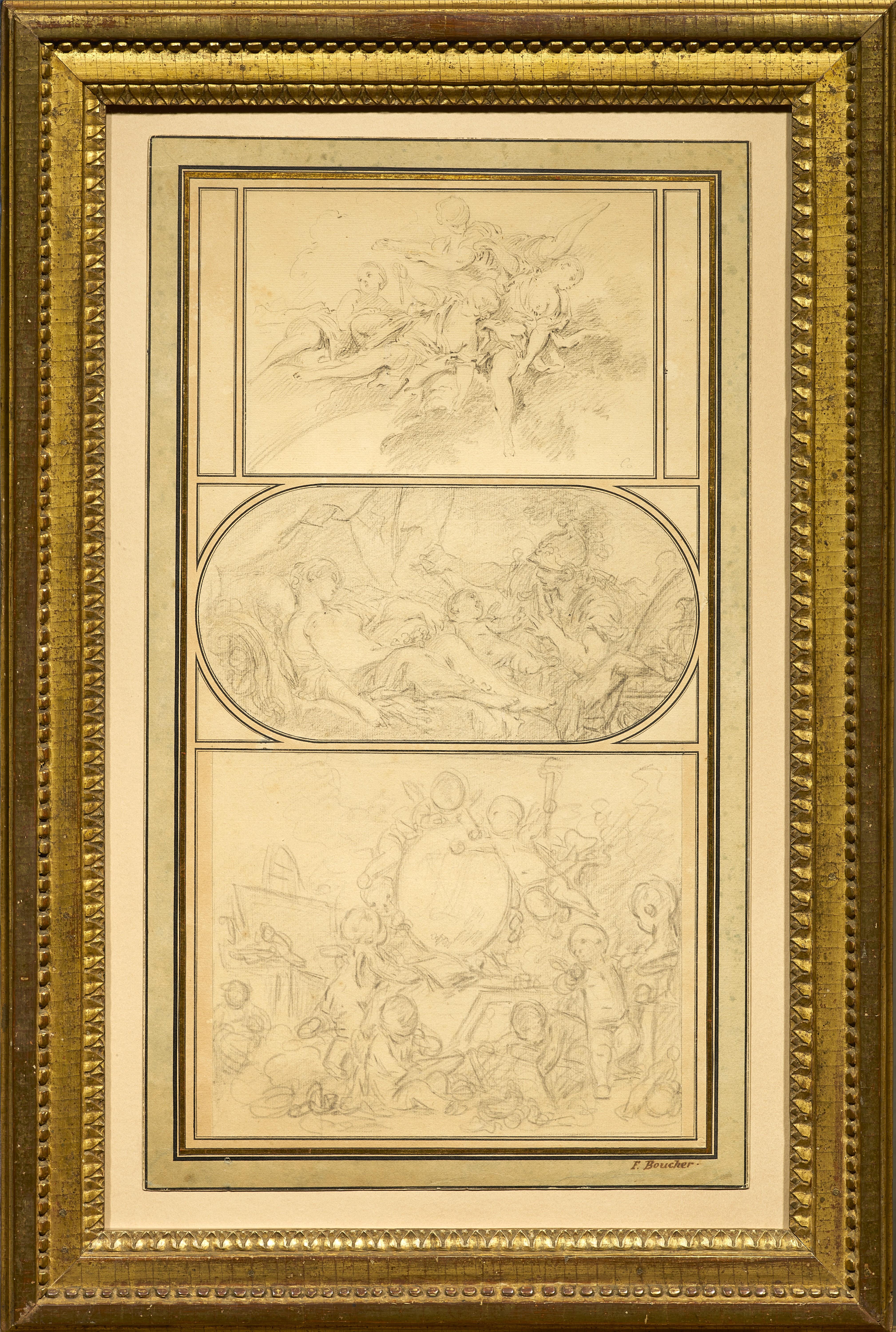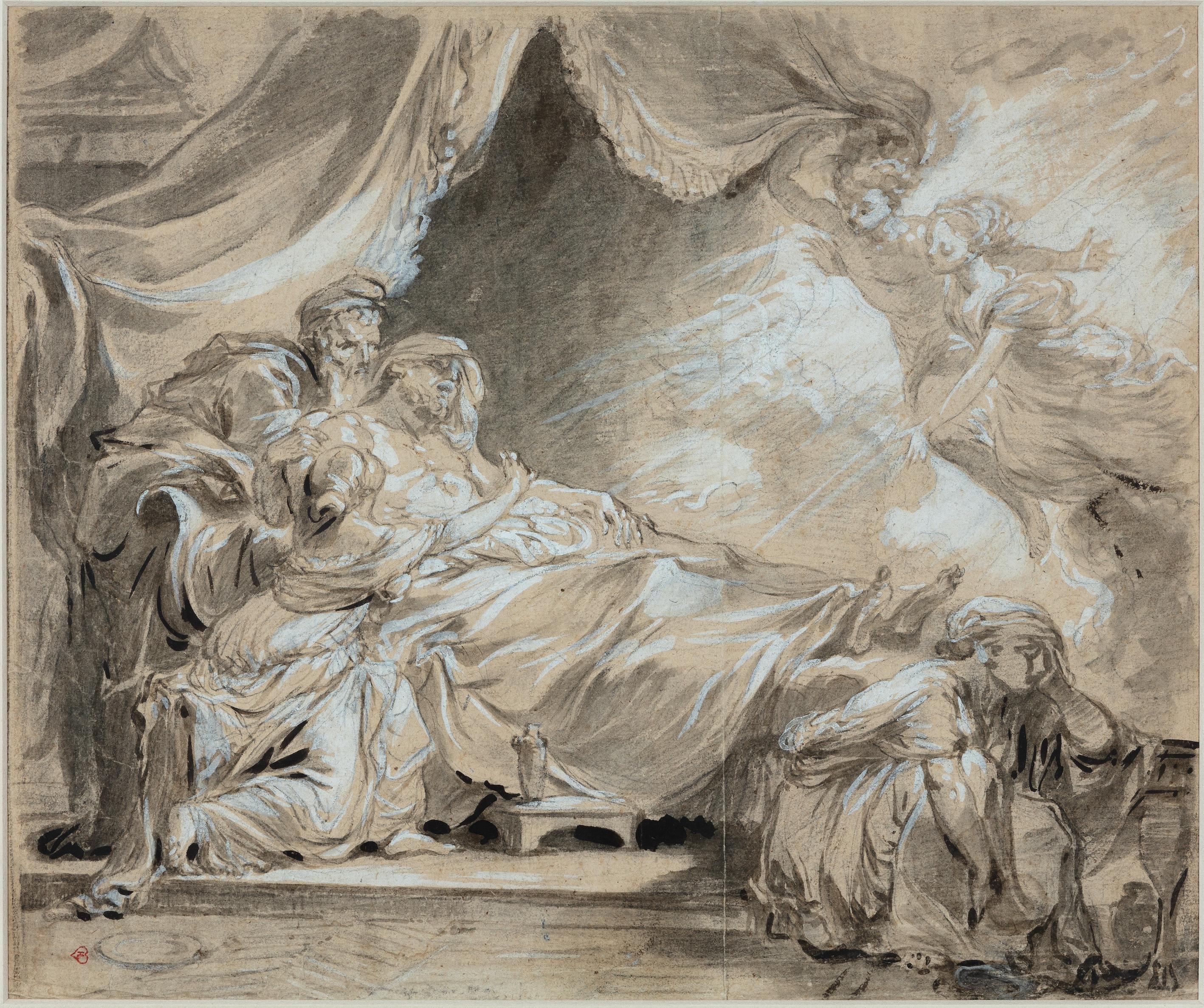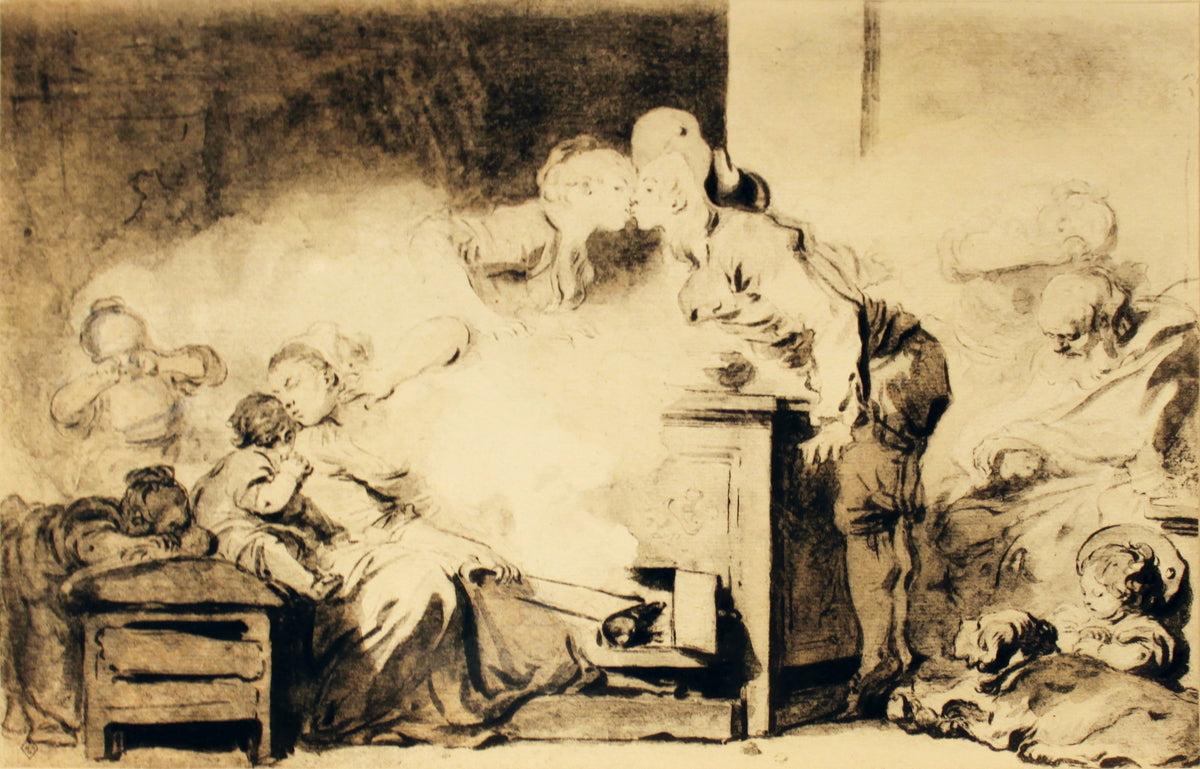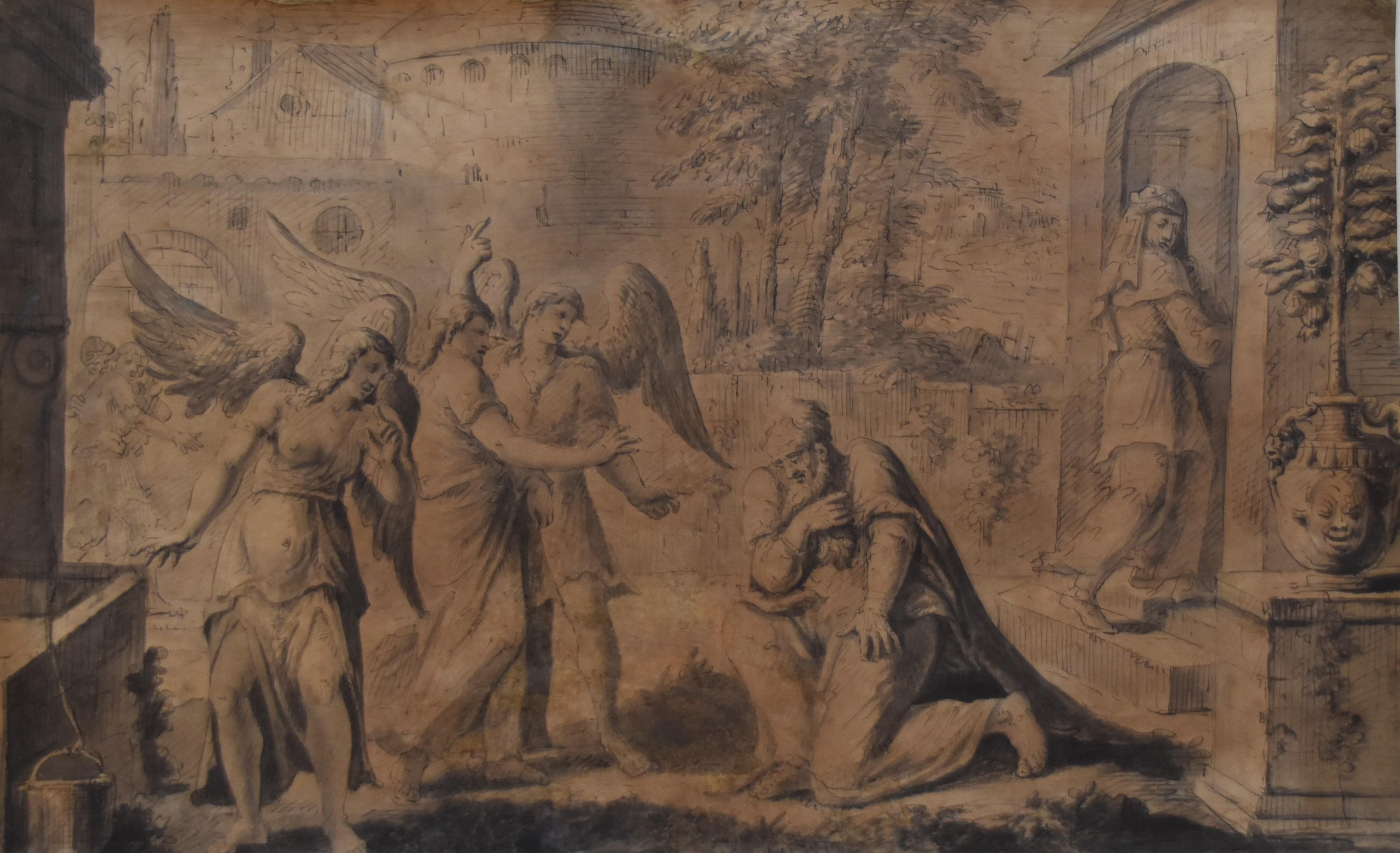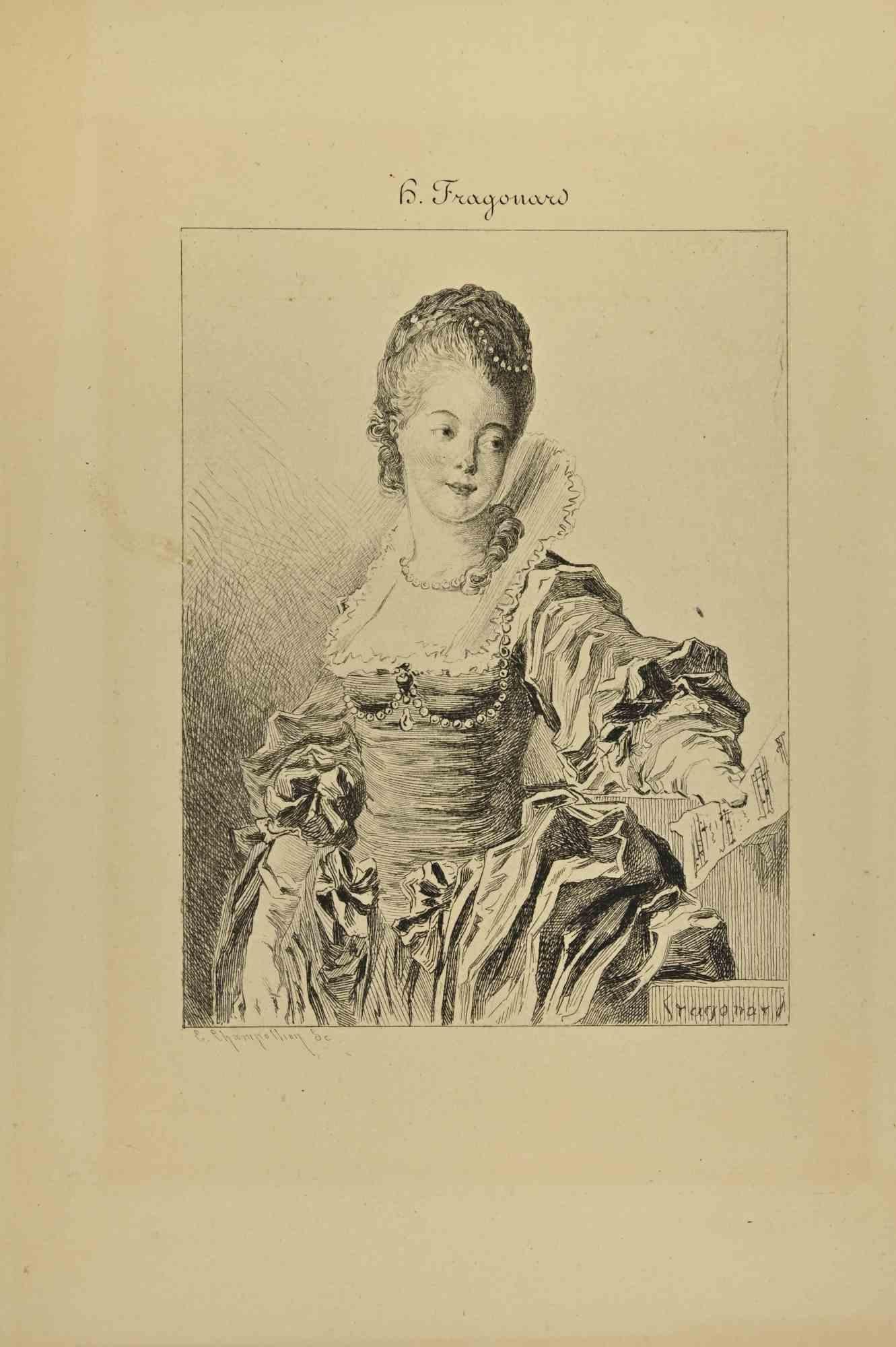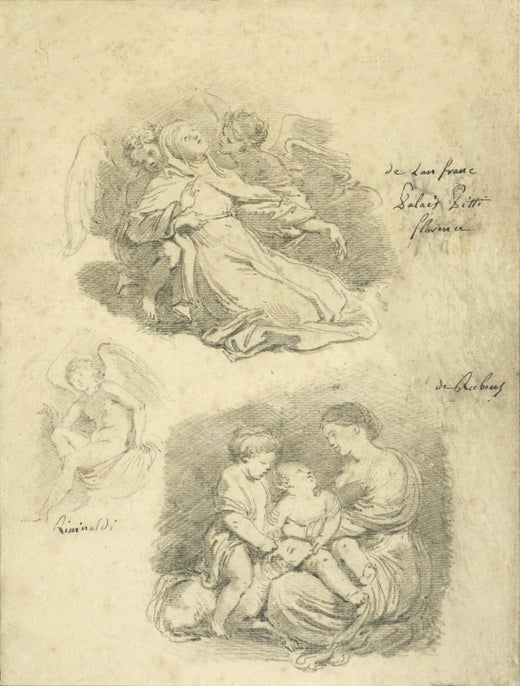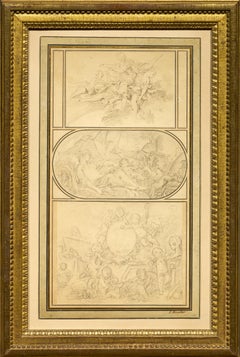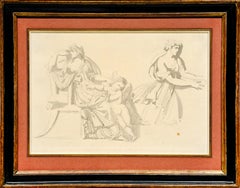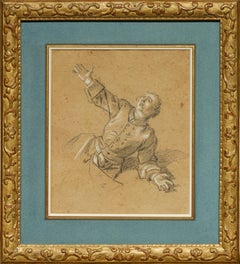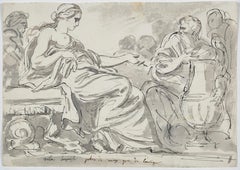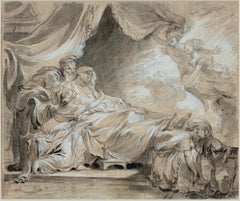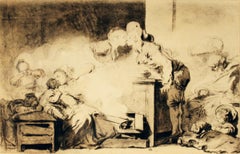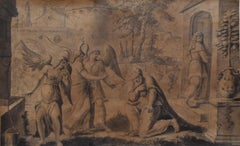Items Similar to Three studies executed in the Pitti Palace in 1761 by Jean-Honoré Fragonard
Want more images or videos?
Request additional images or videos from the seller
1 of 10
Jean-Honoré FragonardThree studies executed in the Pitti Palace in 1761 by Jean-Honoré Fragonard1761
1761
$28,458.46
£21,387.70
€24,000
CA$39,854.66
A$43,708.30
CHF 22,637.83
MX$525,189.59
NOK 285,064.17
SEK 267,540.87
DKK 182,888.32
About the Item
This brilliant study sheet, of which we present here a counterproof, is a souvenir of Fragonard's return journey from Italy. Between April and September 1761, he accompanied the abbot of Saint-Non on his way back to France. Three studies after the masters taken from the Pitti Palace’s gallery in Florence are gathered on this sheet. Although The Ecstasy of Saint Margaret of Cortona by Giovanni Lanfranco and The Holy Family with Saint Elizabeth after Rubens present classical themes, the presence of a mocking angel, a "victorious love" of secular appearance, heralds the gallant scenes that would make the artist famous after his return to Paris.
1. The first stay in Italy, a decisive step in Jean-Honoré Fragonard's artistic development
Jean-Honoré Fragonard was born in Grasse in 1732 where his father worked as a glove maker. The family moved to Paris around 1738. At the age of 13, Jean-Honoré's artistic talents were noticed by the notary with whom he worked as a clerk. After briefly attending Jean-Siméon Chardin's workshop, the young Fragonard joined François Boucher's workshop as an apprentice. It was thanks to Boucher that he affirmed his talent and learned to copy the masters. In 1752, he won the Grand Prix of the Royal Academy of Painting, which allowed him to join the Royal School of Protected Pupils directed at the time by Carle Van Loo. In 1756 he left for the French Academy in Rome where he stayed until 1761.
During this stay he made friends with Jean-Claude Richard de Saint-Non, the famous abbot of Saint-Non, who became his protector and main patron. Although we do not know the exact date of their meeting, during the summer of 1760 they stayed together at the Villa d'Este in Tivoli for several weeks. In March 1761 the abbot de Saint-Non sent Fragonard to Naples at his own expense.
The abbot of Saint-Non then offered Fragonard to accompany him on his return trip to France. Fragonard was 29 years old in 1761 (five years younger than the abbot) and had not yet achieved fame when he left Italy. They left Rome in April 1761 and travelled together for over five months. The abbot wrote to his brother about Fragonard: "Monsieur Fragonard is all fire; his drawings are very numerous: one does not wait for the other; they enchant me. I find spell in them"...
2. The drawings made for the abbot of Saint-Non on his return trip to France
As was customary, the patron paid the travel expenses and in return received from the artist the (numerous) studies made during the trip. At this stage, 370 studies, mostly executed in black stone, are known to have been made during this five-month journey.
Their itinerary was classic: Siena, Florence, Pisa, Venice (where they stayed for six weeks), Padua, Vincenzo, Verona, Mantua, Reggio, Modena, Bologna, Parma and finally Genoa from where they returned to France by sea. They were in Florence between April 17th and May 6th 1761. We learn from the Journal of the abbot that the Pitti Palace was their first visit in Florence.
Most of Fragonard's drawings are not slavish copies of the artworks seen in Italy. As we shall see for the drawing presented here, they present a subjective selection of groups of figures or details that caught the artist's imagination and were deemed interesting as models for his future productions.
The counterproofs were made shortly after their return to Paris in September 1761. It is likely that Saint-Non, who owned a press, supervised their production and annotated them with a pen using grey ink, as the annotations in black stone on the original drawings were illegible after transfer. To make a counterproof, a sheet of wet paper was placed on top of the drawing and the whole thing was pressed, allowing the transfer of the image in reverse. These counterproofs were sometimes redrawn to increase their vigour, either by the abbot de Saint-Non or directly by Fragonard. This does not seem to have been the case for the drawing we present.
One of the purposes of making the counterproofs was probably to enable both Fragonard and the abbot de Saint-Non to have a complete set of drawings. These counterproofs were at the time as highly regarded as the drawings themselves, and were frequently used by artists as a starting point for new compositions.
3. Description of the artwork and related artworks
As always, our counterproof has been pasted on a light cardboard. We believe that it probably comes from a set "composed largely of counterproofs, which has now been divided. [They] belong to descendants of the abbot of Saint-Non living in Paris and its surrounding area".
In this work, Fragonard freely combines the main groups of two paintings from the Palatine Gallery of the Pitti Palace: The Ecstasy of Saint Margaret of Cortona by Giovanni Lanfranco (eigth photo in the gallery) and The Holy Family with Saint Elizabeth, after Rubens (last photo in the gallery). It is interesting to note that in each case he retained only a part of the painting, in a very personal aesthetic re-creation process.
While only the group of Saint Margaret and the two angels is included in Lanfranco's painting, the figure of Saint Elizabeth is omitted in the painting after Rubens, as Fragonard prefers to concentrate on the group formed by the Virgin, the infant Jesus and Saint John the Baptist.
Fragonard balances his sheet by introducing a third element between these two groups, each made of three figures: an evocation of The Victorious Love by Orazio Riminaldi. His sense of interpretation is at its strongest with this painting, as he transforms the dark ephebe painted by the Caravaggio painter into a graceful putto, while taking up the questioning gesture of his hand, which acquires an ironic dimension.
It seems to us that this putto is a forerunner of the statues of love that would adorn the love gardens of the painter's mature compositions, as for example in the Swing (Wallace Collection - London - UK).
4. Framing
The drawing is presented in a carved and gilded wooden frame in the Louis XVI style.
Main bibliographical references :
Pierre Rosenberg (with the collaboration of Barbara Brejon de Lavergnée) - Panopticon Italiano - Edizioni dell' Elefante 1986
Pierre Rosenberg - Fragonard - RMN 1987
Perrin Stein (with contributions by Marie-Anne Dupuy-Vachey, Eunice Williams, Kelsey Brosnan) - Fragonard Drawing Triumphant - The Metropolitan Museum of Art, New York 2016
- Creator:Jean-Honoré Fragonard (1732 - 1806, French)
- Creation Year:1761
- Dimensions:Height: 11.25 in (28.58 cm)Width: 8.5 in (21.59 cm)
- Medium:
- Movement & Style:
- Period:1760-1769
- Condition:11 ¼” x 8 ½” (285 x 215 mm) - Framed: 18 7/8” x 15 ¾” (48 cm x 40 cm) Catalogue: Ananoff 1096 - Panopticon Italiano 130 Louis XVI style carved and gilded wood frame.
- Gallery Location:PARIS, FR
- Reference Number:1stDibs: LU1568211142202
Jean-Honoré Fragonard
ean-Honoré Fragonard (1732–1806) was a French painter and printmaker born in Grasse, France. A leading figure of the Rococo era, Fragonard is celebrated for his playful, sensuous, and elegantly composed works, often depicting scenes of romance, leisure, and aristocratic life. His style is characterized by fluid brushwork, luminous color, and a lighthearted, decorative sensibility that epitomized 18th-century French art. Fragonard’s paintings, such as The Swing, remain enduring symbols of the Rococo period’s charm and refinement.
About the Seller
5.0
Vetted Professional Seller
Every seller passes strict standards for authenticity and reliability
Established in 2020
1stDibs seller since 2021
10 sales on 1stDibs
- ShippingRetrieving quote...Shipping from: PARIS, France
- Return Policy
Authenticity Guarantee
In the unlikely event there’s an issue with an item’s authenticity, contact us within 1 year for a full refund. DetailsMoney-Back Guarantee
If your item is not as described, is damaged in transit, or does not arrive, contact us within 7 days for a full refund. Details24-Hour Cancellation
You have a 24-hour grace period in which to reconsider your purchase, with no questions asked.Vetted Professional Sellers
Our world-class sellers must adhere to strict standards for service and quality, maintaining the integrity of our listings.Price-Match Guarantee
If you find that a seller listed the same item for a lower price elsewhere, we’ll match it.Trusted Global Delivery
Our best-in-class carrier network provides specialized shipping options worldwide, including custom delivery.More From This Seller
View AllThree drawings by François Boucher in a mounting by Jean-Baptiste Glomy
By François Boucher
Located in PARIS, FR
We would like to thank Juliette Parmentier-Courreau of the Custodia Foundation for her welcome and support during the consultation of Glomy’s Journal des Ouvrages.
This spectacularly large "feuille de desseins ajustés" commissioned by François Boucher from Jean-Baptiste Glomy is emblematic of the painter's art and mastery of rocaille. It is also fully representative of the taste of this period in the field of decorative arts. The largest of these three drawings, placed at the bottom of the composition, is particularly interesting: dating from around 1756, it constitutes a modello (apparently unpublished) for the frontispiece of the "Catalogue des tableaux de Monsieur de Julienne"), preserved in the Morgan Library in New York.
1. François Boucher, the master of French rocaille
The extraordinary career of Francois Boucher was unmatched by his contemporaries in versatility, consistency and output. For many, particularly the writers and collectors who led the revival of interest in the French rococo during the last century, his sensuous beauties and plump cupids represent the French eighteenth century at its most typical. His facility with the brush, even when betraying the occasional superficiality of his art, enabled him to master every aspect of painting – history and mythology, portraiture, landscape, ordinary life and, as part of larger compositions, even still life. He had been trained as an engraver, and the skills of a draftsman, which he imbued in the studio of Jean-Francois Cars (1661 – 1738), stood him in good stead throughout his career; his delightful drawings are one of the most sought-after aspects of his oeuvre.
As a student of Francois Lemoyne (1688 - 1737), he mastered the art of composition. The four years he spent in Italy, from 1727-1731, educated him in the works of the masters, classics and history, that his modest upbringing had denied him.
On his return to Paris in 1734, he gained full membership of the Royal Academy of Painting and Sculpture with his splendid Rinaldo and Armida (Paris, Musée du Louvre). Although, throughout his career, he occasionally painted subjects taken from the Bible, and would always have considered himself first as a history painter, his own repertoire of heroines, seductresses, flirtatious peasant girls and erotic beauties was better suited to a lighter, more decorative subject matter. His mastery of technique and composition enabled him to move from large scale tapestry...
Category
1750s Old Masters Figurative Drawings and Watercolors
Materials
Chalk, Ink
Frieze of antique figures, a drawing by the sculptor Antoine-Denis Chaudet
Located in PARIS, FR
Faithful to the neo-classical taste, sculptor Antoine-Denis Chaudet presents us with a frieze of antique figures executed in gray wash over pencil strokes, which is likely inspired b...
Category
Early 1800s Old Masters Figurative Drawings and Watercolors
Materials
Paper, Pencil, Ink
Soldier begging for Mercy a preparatory study by Jean-Marc Nattier (1685 - 1766)
By Jean-Marc Nattier
Located in PARIS, FR
This rare drawing by Nattier is part of a set of preparatory studies executed in 1717 for one of the painter's first commissions, the painting commissioned by Tsar Peter I of Russia ...
Category
1710s Old Masters Figurative Drawings and Watercolors
Materials
Chalk
Study in the Antique Style, a neoclassical drawing by Augustin Pajou
Located in PARIS, FR
In this lively and fresh drawing, probably taken from one of the artist's notebooks, Pajou presents us with a composition freely inspired by antiquity, as a souvenir of a visit to th...
Category
1750s Old Masters Figurative Drawings and Watercolors
Materials
Ink
Studies for the Judgment of Solomon, a double-sided drawing by Simone Cantarini
Located in PARIS, FR
In this double-sided red chalk study, Simone Cantarini offers us a double reflection on the theme of the Judgment of Solomon. This sheet reveals his precise style and his sense of de...
Category
1640s Old Masters Figurative Drawings and Watercolors
Materials
Chalk, Laid Paper
Study for a Frontispiece, a baroque drawing by Giovanni Antonio Pellegrini
By Giovanni Antonio Pellegrini
Located in PARIS, FR
This masterly frontispiece study, executed with a very sure hand, testifies to the survival of the great Baroque taste in 18th century Venice. It could be one of the very last works by Giovanni Antonio Pellegrini: the few lines that cross the papal arms evoke those of Benedict XIV, who became pope in 1740, one year before the artist's death.
1. Giovanni Antonio Pellegrini and the European influence of Venetian history painting in the 18th century
Giovanni Antonio Pellegrini was born in Venice in 1675 and trained in the studio of the Milanese painter Paolo Pagani (1655 - 1716). Pagani, who had been living in Venice since 1667, took him to Moravia and Vienna from 1690 to 1696. After a stay in Rome from 1699 to 1701, Pellegrini married Angiola Carriera in 1704, the sister of the great pastelist Rosalba Carriera.
From 1708 onwards, Pellegrini left Venice and began an extensive tour of Europe: he worked in England between 1708 and 1713, where he met great success, particularly at Kimbolton Castle and Castle Howard. He then worked in Germany and the Netherlands, then in Bohemia and Austria, before returning briefly to England in 1719. In 1720 he was in Paris where he decorated the ceilings of the Royal Bank for John Law...
Category
1740s Old Masters Figurative Drawings and Watercolors
Materials
Ink
You May Also Like
The Death of Coresus
By Jean-Baptiste Greuze
Located in Paris, Île-de-France
JEAN-BAPTISTE GREUZE
(Tournus 1725 - 1805 Paris)
The Death of Coresus, circa 1750
Pen and brown ink, black ink tips, gray wash on black chalk, 455 x 385 cm
Bears on the reverse in ...
Category
18th Century Old Masters Figurative Drawings and Watercolors
Materials
Ink, Watercolor
Peaceful Maternity : the Sleeping Baby - Etching
By François Boucher
Located in Paris, IDF
Francois BOUCHER
Peaceful Maternity : the Sleeping Baby
Etching
Unsigned
On Vellum 38 x 50 cm (c. 15 x 20 in)
Probably edited c. 1950
Excellent condition
Category
20th Century Mannerist Figurative Prints
Materials
Etching
Jean-Honore Fragonard-L'Occasion Rococo Vintage
By Jean-Honoré Fragonard
Located in Brooklyn, NY
Drawings by French Masters of the XV-XVIII Centuries. From a selection of 40 reproductions of the originals preserved in the Albertina Collection in Vienna. With an introduction and...
Category
1930s Rococo Interior Prints
Materials
Offset
François Boitard (1670-1715) Abraham and the Three Angels, original drawing
Located in Paris, FR
François Boitard (1670-1715)
Abraham and the Three Angels,
Signed lower left "F Boitard (...) fecit (...)"
28 x 44 cm
Pen and ink on yellow prepared paper...
Category
Early 1700s Old Masters Figurative Drawings and Watercolors
Materials
Ink
Fragonard - Etching by Eugène Chambellier - 19th century
Located in Roma, IT
Fragonard is a print realized by Eugène Chambellier (1848-1901) in the 19th century.
Etching on paper
Good condition with slight foxing.
Category
19th Century Modern Portrait Prints
Materials
Etching
Jules Cheret (1836-1932) Three studies of women, original signed drawing
By Jules Chéret
Located in Paris, FR
Jules Cheret (1836-1932)
Three studies of women
charcoal on paper
signed on the bottom left
39 x 24.5 cm
This drawing of studies was part of the artist's workshop as so it bears the...
Category
1910s Art Nouveau Figurative Drawings and Watercolors
Materials
Charcoal
